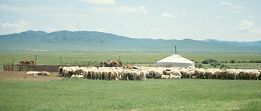 The buffer zone project can factually be characterized as a ’community development project.’ Effective buffer zone management requires the active participation of four specific groups of stakeholders: the herdsmen and the three village communities, municipal councils, the administrative body of Hustai National Park and the Buffer Zone Council. All these participating groups will be involved in management strategy.
The buffer zone project can factually be characterized as a ’community development project.’ Effective buffer zone management requires the active participation of four specific groups of stakeholders: the herdsmen and the three village communities, municipal councils, the administrative body of Hustai National Park and the Buffer Zone Council. All these participating groups will be involved in management strategy.
The buffer zone project strives towards the integration of buffer zone and Park management, whereby the sustainable preservation of the National Park’s own unique biodiversity remains the binding factor. The basis of the project is the stimulation of self-help. Essential for the sustainable management of the buffer zone is the control over the grassland areas, water, other natural resources and small-scale enterprises.
 Starting point are the smallest possible basic groups of herdsmen and villagers. Guided by experts these groups will learn to profile themselves and to develop their capacity to estimate, plan, organize, manage and control themselves, the natural resources or initiated enterprises. It is the only way to come to a sound management of the grasslands, control of water resources, improvement of livestock quality, product distribution and other significant issues.
Starting point are the smallest possible basic groups of herdsmen and villagers. Guided by experts these groups will learn to profile themselves and to develop their capacity to estimate, plan, organize, manage and control themselves, the natural resources or initiated enterprises. It is the only way to come to a sound management of the grasslands, control of water resources, improvement of livestock quality, product distribution and other significant issues.
The most important groups of stakeholders (herdsmen, park staff, buffer zone committees, Buffer Zone Council, municipal councils and representatives from the relevant ministries) will be involved in a training program.
In order to improve living standards in the buffer zone, a Buffer Zone Development Fund was established under the Hustai National Park Trust and financed by the Dutch government.
As a result of the consultation, training and mutual cooperation, some 30 herders groups were established in the buffer zone. They are engaged in a number of business activities in order to improve their families’ incomes in addition to what they earn from livestock. These activities include live stock farms, vegetable farms, felt making including shops where the felt products are sold, community based tourism, etc. Local hospitals, schools and governor offices received subsidies for the development of kindergartens, hospitals, hospital laboratories, teachers’ accomodation, cultural centres, etc.
